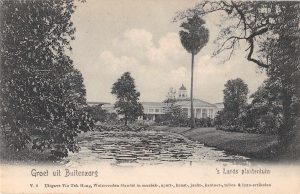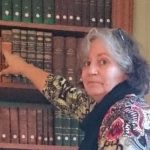Celebrating the 100th anniversary of Wageningen University: Illustrating science
Participants of the workshop and co-authors: Ellen Fest, Shauna Ni Fhlaithearta, Koos Nijssen and Gerrie Holmer.
This is the third blog post in the series about the 100th anniversary of Wageningen University. We highlight the Image Collections of Wageningen University & Research by showing some fascinating examples. The collection contains a wide variety of visuals, like drawings, maps and photographs created for and used by scientists.
Betje Polak: Pioneer of peat research in the Netherlands East Indies

Betje Polak
Betje Polak worked in the Netherlands East Indies from 1930 to 1954. She travelled several times to Java, Borneo and Sumatra to research peat soils. She made 260 detailed drawings of pollen and spores during this period. A lot of the drawings were made in the Botanical Garden Buitenzorg at Bogor. The drawings, which made a significant contribution to the development of peat research, can be seen and downloaded from the Image Collections of Wageningen University & Research.
An impression of Botanical Garden at Bogor, West Java

Buitenzorg, ‘s Lands plantentuin, Bogor
Betje Polak graduated cum laude in 1929 with the thesis: “Onderzoek naar de botanische samenstelling van het Hollandsche Veen” (“A study of the botanical composition of Dutch peat soil”) at the Municipal University of Amsterdam (University of Amsterdam). You can find a hard copy of her thesis in the collection of WUR Library. She was a well-respected peat specialist in the Netherlands, however, because the Netherlands was in a severe economic crisis at the time, she emigrated to the Netherlands East Indies. After a few years, she returned to the Netherlands. She went back to Java in 1939. Several years after the start of World War II in Europe, the Japanese occupation of the Netherlands East Indies began. Betje was interned in a camp during the Japanese occupation. During the internment her physical and mental health deteriorated rapidly. After the war she visited the Department of Agriculture in Florida to work with peat specialist S. Waksman. After a third stay in Indonesia, just a few years after independence, she returned to the Netherlands permanently. She had received an invitation from the professor of Soil Science C.H. Edelman to work with him at the Department of Regional Soil Science at the Agricultural University in Wageningen.
Source: Havinga and Muller. 1981. In memoriam Betje Polak (1901-1980), pioneer of peat research in the Netherlands and in the tropics. Acta Botanica Neerlandica 30 (5/6), 337-343.
Examples of drawings by Betje Polak
Botany and Phytopathology
This small selection of the botanical drawings from the Laboratory of Plant Systematics shows the artistic and technical diversity of plant and vegetable drawings by artists who worked for Wageningen University and Research from 1900 to 1985.
Examples from the Botanical drawings collection
The Botanical drawings were made by several scientific illustrators, e.g Mariet de Geus, Johan Haak and F. Eichler.
For quite some years students could complete a course botanical illustration. Botanical illustration was an important part of plant description; living nature was copied in an exact scientifically way. Plant material was obtained from the Botanical Gardens of the University. The collection of botanical drawings contains more than 1900 drawings of plants, shrubs and trees, created between 1900 and 1985. Some botanical drawings show multiple species. These drawings are available in the Image Collections.
Special publications on illustrating science
Now and then publications with beautiful drawings were published by WUR Library on special occasions. Two examples:
1. Tekenen van Leven (Signs of Life). Tekeningen, aquarellen en kaarten ten behoeve van de landbouwwetenschappen. Wageningen, Pudoc, 1984. ‘Signs of Life’, a set of 16 illustrations, focuses on a special aspect of scholarly publishing: the hand-made scientific illustration and its maker.
2. Icones selectae Vadenses. Selected reproductions from the collection of Wageningen Agricultural University, 1994. This is a small selection with 10 reproductions of prints and drawings from the Special Collections of WUR Library.
Copyrights and use
The material in WUR Image Collections is intended for personal use. WUR Image Collections indicates copyright owners for each of the collections, in the grey text box on each collection page of the Image Collections. When you want to use an image in a publication or on a website, we kindly request you to contact the copyright owner for information how to attribute. This information can be found on each collection page.
Add a new collection
Do you have a collection of images related to WUR research? Do you want to share them with a wider audience? Please contact Joke.Webbink@wur.nl, to discuss the possibilities.


